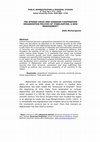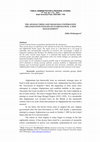Papers by Jildiz Nicharapova
Eurasia Szemle IV 2 ENG online, 2024
Following extensive negotiations and protests from certain quarters against the initiative, the K... more Following extensive negotiations and protests from certain quarters against the initiative, the Kyrgyz
Republic acceded to the Eurasian Economic Union (EAEU) in 2015. Since accession, contradictory
opinions have been voiced among the population, government officials and various organisations in
Kyrgyzstan about the benefits and drawbacks in economic and other fields for the nation. This article
aims to analyse the economic results of the participation of the Kyrgyz Republic in the EAEU. It
studies the main economic indicators and additionally highlights a selection of challenges in the
economic sphere.
Evolving regional values and mobilities in global contexts The emergence of new (Eur)Asian regions and dialogues with Europe, 2020
This chapter focuses on and generalises from the case of the Kyrgyz
Republic while probing into o... more This chapter focuses on and generalises from the case of the Kyrgyz
Republic while probing into one simple fact. Regional powers use
international organisations to forward their politics in world regions. This
is clearly the case in Central Asia, where Russia created and leads various
organisations in multiple spheres and where China created the Shanghai
Cooperation Organisation (SCO) and the Belt and Road Initiative (BRI).
Thus, the question is whether such organisations that serve the interests
of these regional powers are equally beneficial for Central Asian states.
The Completion of Eurasia? Continental convergence or regional dissent in the context of ‘historic turns’, 2023
This chapter analyses Kyrgyzstan’s participation in the Eurasian Economic
Union (EAEU, sometimes ... more This chapter analyses Kyrgyzstan’s participation in the Eurasian Economic
Union (EAEU, sometimes EEU) and whether the EAEU complies with, or
fulfils, the country’s expectations in the economic sphere. In other words, are
planned goals achieved? The history of the EAEU and Kyrgyzstan’s accession
to the organisation as a framework, highlights the impact of the EAEU on
the county’s economic development by echoing the question of whether the
participation of Kyrgyzstan in the EAEU meets Bishkek’s national interests.
Cross-Border Exchanges Eurasian perspectives on logistics and diplomacy, 2019
This chapter discusses the security threats in Central Asia and the activities
of international a... more This chapter discusses the security threats in Central Asia and the activities
of international and regional structures in solving them. After presenting
these security issues in Central Asia, it describes the participation and
activities of Central Asian states in regional organisations. It then discusses
the activities and effectiveness of the main international organisations
in the central Asian security spheres and analyses cooperation or non-
cooperation among three such main organisations as the CSTO, the
SCO and the NATO.

LOGISTICS & DIPLOMACY IN CENTRAL ASIA, 2022
This chapter discusses cooperation of Kyrgyz Republic and China within Belt and Road Initiatives ... more This chapter discusses cooperation of Kyrgyz Republic and China within Belt and Road Initiatives especially road construction projects together with other infrastructural projects. Historical background on development of cooperation among two neighbours in different spheres will be analysed and how the creation of BRI impacted the cooperation among them. What are the impacts of BRI projects on Kyrgyzstan in terms of development? Our chapter consists of two parts. First, we will analyse the cooperation between Kyrgyzstan and China within BRI since its creation. We will analyse benefits and problems of cooperation for Kyrgyzstan since BRI is seen as a project which is uniquely beneficial for China. We will discuss the history of cooperation between Kyrgyz Republic and China since the independence of Kyrgyzstan in economic and other spheres. In the second chapter we will analyse the construction of roads in Kyrgyz Republic with the financial support of China within BRI and its benefits for Kyrgyzstan and China.
Central Asia is the term used to refer to the five independent states located in the heart of Asi... more Central Asia is the term used to refer to the five independent states located in the heart of Asia and bordering great powers like China and Russia. These five countries-Kazakhstan, Kyrgyzstan, Tajikistan, Turkmenistan, and Uzbekistan-were part of the USSR and gained independence after its collapse. They have relatively similar cultures and the populations of all of

Handbook on BRI, 2022
The cooperation between China and the Central Asian republics, particularly as it relates to the ... more The cooperation between China and the Central Asian republics, particularly as it relates to the Belt and Road Initiative (BRI) in Central Asia, has become a highly discussed subject in the region. Despite this, there is not much research discussing the impact of the BRI on the economies of the Central Asian countries. It is evident that Central Asia is the most important region for China in terms of economic, security, and social issues. The landbound leg of the BRI is the Silk Road Economic Belt (SREB), which passes through Central Asia before reaching its desired destinations, making the region critical to China's goals for the BRI (Yazdani, 2020, p. 189). Central Asia thus forms a key component of the BRI (Dilleen, 2017), and many works discuss the reasons behind the importance of Central Asia for China. According to some scholars, Central Asia is valuable to China because of the region's energy and mineral resources (Duarte, 2019, p. 167; Garlick, 2020, p. 7; Sim & Aminjonov, 2020, p. 21). Central Asia's geographical and cultural proximity to China's restive Xinjiang also informs Beijing's focus on these states (Sim & Aminjonov, 2020, p. 22). Since the introduction of the BRI in 2013, all cooperation projects and any cooperation between China and other nations have been related to BRI projects. According to Aminjonov et al. (2019, p. 1), projects are regarded as part of the BRI if they meet the criteria of being publicly reported as a BRI project, regardless of whether projects are fully or partially financed by the BRI financial institutions, such as the Asian Infrastructure Investment Bank (AIIB), China Development Bank, Export-Import Bank of China or New Silk Road Fund, or are implemented and financed via a bilateral or multilateral format. The BRI provides opportunities for Central Asia in return for its use as a gateway connecting China with West Asia and Europe, namely through enabling the building of infrastructure with China's financial assistance, thereby reducing logistics costs, expanding trade, and attracting

La question principale de notre travail de recherche est: A quel type d'organisation internat... more La question principale de notre travail de recherche est: A quel type d'organisation internationale appartient l'OCS et quels sont ses buts d'existence ? Pourquoi les pays-membres coopèrent-ils au sein de l'Organisation ? Pourquoi coopèrent-ils dans des domaines dont ils ont établi les règles de coopération et sur quelles questions spécifiques ont-ils choisi de répondre ? Quels sont ses règles et les mécanismes de prise de décision, et quels sont sa structure organisationnelle et son mode de fonctionnement ? La deuxième question est : quelles sont ses raisons d'existence, ses buts et ses objectifs? Et la troisième interrogation est quelles sont ses promesses (potentiels) et ses limites ? En se basant sur la « théorie » des organisations internationales, à quel type d'organisation internationale l'OCS peut-elle appartenir ? Une Organisation de coopération ou d'intégration ? On peut se demander quels sont les véritables objectifs d'une telle organis...
Świat Idei i Polityki, 2020
This paper uses the case of Kyrgyz Republic to analyze two competing views concerning the role of... more This paper uses the case of Kyrgyz Republic to analyze two competing views concerning the role of the Eurasian Economic Union (EAEU). The realist view claims that the EAEU is a tool of Russian hegemonic power over its region of influence and interprets is as a primarily political rather than economic organization designed to serve Russia's national interests at the expense of those of other members. The liberal institutionalist view, on the other hand, sees the EAEU as a new regional organization of economic integration that is beneficial for all members. Analyzing the case of the participation of the Kyrgyz Republic in this union makes it clear that it is still too early yet to determine which perspective is correct as there is evidence in support of both.

The main research question of the article is what attitude present the North Atlantic Treaty Orga... more The main research question of the article is what attitude present the North Atlantic Treaty Organization, the Shanghai Cooperation Organisation and the Collective Security Treaty Organization towards Afghanistan after 2014? A number of detailed questions were also put to help to answer the main question. The article consists of eight chapters. The first chapter discusses the methodological assumptions of the article. Chapter two covers literature review and theoretical framework of the article. The following chapters include an analysis of the approach to Afghanistan of the three indicated international organizations. The article ends with conclusion that contain the main theses.A principal questão de pesquisa deste artigo é que atitudes apresentam a Organização do Tratado do Atlântico Norte (OTAN), a Organização para Cooperação de Xangai (OCX) e a Organização do Tratado de Segurança Coletiva (OTSC) em relação ao Afeganistão após 2014? Também foram colocadas várias perguntas detalh...
Austral: Brazilian Journal of Strategy and International Relations, 2020
The main research question of the article is what attitude present the North Atlantic Treaty Orga... more The main research question of the article is what attitude present the North Atlantic Treaty Organization, the Shanghai Cooperation Organisation and the Collective Security Treaty Organization towards Afghanistan after 2014? A number of detailed questions were also put to help to answer the main question. The article consists of eight chapters. The first chapter discusses the methodological assumptions of the article. Chapter two covers literature review and theoretical framework of the article. The following chapters include an analysis of the approach to Afghanistan of the three indicated international organizations. The article ends with conclusion that contain the main theses.

Central Asia has become a geopolitical chessboard for the superpowers. There are few places as im... more Central Asia has become a geopolitical chessboard for the superpowers. There are few places as important to US national security as the tribal belt along Pakistan and Afghanistan border region. The region serves as a safe haven for a core group of nationally and internationally networked of terrorists and increasingly a hotbed of indigenous militancy that threatens the stability of not only to Afghanistan and Pakistan but the entire Central Asian Region. It is estimated that nearly one hundred Islamic extremist groups and jihadi organizations with cross border linkages are operating with impunity throughout South Asia. In our paper we are intending to propose possible ways of strengthening and developing SCO's potential in solving security, political, economic problems in Afghanistan with ultimate goal of preserving regional security free from terrorism, extremism, and drug trafficking that conducts to political and economic prosperity of all countries in the region.

The main question of our research is what kind of international organization is the SCO and what ... more The main question of our research is what kind of international organization is the SCO and what are its reasons for existence? In terms of the theory of international organizations to which type of international organization, the SCO can belong? The Organization of cooperation or integration? One wonders what the real objectives of the organization. Is the SCO aims to counteract the West, or there are other reasons for its existence? What are those reasons? Is it destined to exercise a single regional role in the manner of existing organizations such as CSTO, ECO, CIS, etc..., or does it move into the ranks of a world power? Are the objectives of the existence of this structure is to serve the great powers like Russia and China or it is also to serve to the small countries of Central Asia? Do the member countries have common objectives or individual, selfish? Is the SCO is an instrument of countries to achieve their national interests or they have a common desire to unite and grow ...
Peter Lang, 2014
This article discusses the participation of Kyrgyzstan in SCO. Published in 2014 in French language

Peter Lang , 2018
This chapter discusses the security threats in Central Asia and the activities of international a... more This chapter discusses the security threats in Central Asia and the activities of international and regional structures in solving them. After presenting these security issues in Central Asia, it describes the participation and activities of Central Asian states in regional organisations. It then discusses the activities and effectiveness of the main international organisations in the central Asian security spheres and analyses cooperation or noncooperation among three such main organisations as the CSTO, the SCO and the NATO. Central Asia consists of five post-soviet states with a population of over 65 million inhabitants, a geopolitically important region situated between Russia, China, the EU and the rest of Asia, that possesses vast energy resources. Central Asia shares a long border with Afghanistan of 2400 km. There exist several security threats in this region, most of them stemming from Afghanistan. The main security issue is terrorism, extremism and religious radicalisation. Citizens of Central Asia were found in the ranks of ISIS and terrorist attacks organised in the territories of Central Asia. More youth are getting radicalised. In the recent five years, all Central Asian countries have strived to control the activities of religious organisations and spiritual life of citizens. International terrorist/extremist organisations are active in Central Asian states: Hizb-ut Tahrir, Jaishul Mahdi, ISIS, the
AMEZ – Argumente und Materialien der Entwicklungszusammenarb, 2020
Great powers often establish regional or international organizations in order to forward their po... more Great powers often establish regional or international organizations in order to forward their political agenda region. Russia uses many organizations in all political and economic spheres; China created the Shang- hai Cooperation Organisation (SCO) and recently the Belt ad Road Initiative (BRI). In this article, we discuss if these organiza- tions only serve regional powers interests or if they are also beneficial for Central Asian states.
Austral: Brazilian Journal of Strategy & International Relations, 2020
This paper discusses attitudes of NATO, CSTO and SCO towards the situation in Afghanistan after t... more This paper discusses attitudes of NATO, CSTO and SCO towards the situation in Afghanistan after the withdrawal of ISAF.

Świat Idei i Polityki, 2019
The main goal of this paper is analysis of activities, purposes, problems of the SCO since its in... more The main goal of this paper is analysis of activities, purposes, problems of the SCO since its inception in order to understand what is the main reason of its creation and existence? What are its achievements and what benefits have got each member state? Is it beneficial to all members? The hypothesis is put that SCO serves only to its big members, it was intended to be a China tool to enter Central Asia without vexing Russia. The article is going to analyze the activities of the SCO with the existing theories in IR in order to answer questions above. The main objective of the SCO was an attempt by the powers of the Central Asia to control the region. The SCO faces problems of distrust between its members. SCO is very important instrument of guaranteeing Sino-Central Asian partnership. It is also a guarantee that China will never dominate Central Asia due to many signed agreements within the organization. With more than twenty years of history and existence, the SCO may become a real force on the international arena. the SCO's intention is to become a world power and to construct a fairer international order. The SCO has the economic potential and political will to do it .
Świat Idei i Polityki, 2020
This paper uses the case of Kyrgyz Republic to analyze two competing views concerning the role of... more This paper uses the case of Kyrgyz Republic to analyze two competing views concerning the role of the Eurasian Economic Union (EAEU). The realist view claims that the EAEU is a tool of Russian hegemonic power over its region of influence and interprets is as a primarily political rather than economic organization designed to serve Russia's national interests at the expense of those of other members. The liberal institutionalist view, on the other hand, sees the EAEU as a new regional organization of economic integration that is beneficial for all members. Analyzing the case of the participation of the Kyrgyz Republic in this union makes it clear that it is still too early yet to determine which perspective is correct as there is evidence in support of both.

PUBLIC ADMINISTRATION & REGIONAL STUDIES, 2016
Central Asia has become a geopolitical chessboard for the superpowers. There are few places as im... more Central Asia has become a geopolitical chessboard for the superpowers. There are few places as important to US national security as the tribal belt along Pakistan and Afghanistan border region. The region serves as a safe haven for a core group of nationally and internationally networked of terrorists and increasingly a hotbed of indigenous militancy that threatens the stability of not only to Afghanistan and Pakistan but the entire Central Asian Region. It is estimated that nearly one hundred Islamic extremist groups and jihadi organizations with cross border linkages are operating with impunity throughout South Asia. In our paper we are intending to propose possible ways of strengthening and developing SCO's potential in solving security, political, economic problems in Afghanistan with ultimate goal of preserving regional security free from terrorism, extremism, and drug trafficking that conducts to political and economic prosperity of all countries in the region.











Uploads
Papers by Jildiz Nicharapova
Republic acceded to the Eurasian Economic Union (EAEU) in 2015. Since accession, contradictory
opinions have been voiced among the population, government officials and various organisations in
Kyrgyzstan about the benefits and drawbacks in economic and other fields for the nation. This article
aims to analyse the economic results of the participation of the Kyrgyz Republic in the EAEU. It
studies the main economic indicators and additionally highlights a selection of challenges in the
economic sphere.
Republic while probing into one simple fact. Regional powers use
international organisations to forward their politics in world regions. This
is clearly the case in Central Asia, where Russia created and leads various
organisations in multiple spheres and where China created the Shanghai
Cooperation Organisation (SCO) and the Belt and Road Initiative (BRI).
Thus, the question is whether such organisations that serve the interests
of these regional powers are equally beneficial for Central Asian states.
Union (EAEU, sometimes EEU) and whether the EAEU complies with, or
fulfils, the country’s expectations in the economic sphere. In other words, are
planned goals achieved? The history of the EAEU and Kyrgyzstan’s accession
to the organisation as a framework, highlights the impact of the EAEU on
the county’s economic development by echoing the question of whether the
participation of Kyrgyzstan in the EAEU meets Bishkek’s national interests.
of international and regional structures in solving them. After presenting
these security issues in Central Asia, it describes the participation and
activities of Central Asian states in regional organisations. It then discusses
the activities and effectiveness of the main international organisations
in the central Asian security spheres and analyses cooperation or non-
cooperation among three such main organisations as the CSTO, the
SCO and the NATO.
Republic acceded to the Eurasian Economic Union (EAEU) in 2015. Since accession, contradictory
opinions have been voiced among the population, government officials and various organisations in
Kyrgyzstan about the benefits and drawbacks in economic and other fields for the nation. This article
aims to analyse the economic results of the participation of the Kyrgyz Republic in the EAEU. It
studies the main economic indicators and additionally highlights a selection of challenges in the
economic sphere.
Republic while probing into one simple fact. Regional powers use
international organisations to forward their politics in world regions. This
is clearly the case in Central Asia, where Russia created and leads various
organisations in multiple spheres and where China created the Shanghai
Cooperation Organisation (SCO) and the Belt and Road Initiative (BRI).
Thus, the question is whether such organisations that serve the interests
of these regional powers are equally beneficial for Central Asian states.
Union (EAEU, sometimes EEU) and whether the EAEU complies with, or
fulfils, the country’s expectations in the economic sphere. In other words, are
planned goals achieved? The history of the EAEU and Kyrgyzstan’s accession
to the organisation as a framework, highlights the impact of the EAEU on
the county’s economic development by echoing the question of whether the
participation of Kyrgyzstan in the EAEU meets Bishkek’s national interests.
of international and regional structures in solving them. After presenting
these security issues in Central Asia, it describes the participation and
activities of Central Asian states in regional organisations. It then discusses
the activities and effectiveness of the main international organisations
in the central Asian security spheres and analyses cooperation or non-
cooperation among three such main organisations as the CSTO, the
SCO and the NATO.